
Garsten Abbey (German : Stift Garsten) is a former Benedictine monastery located in Garsten near Steyr in Upper Austria. Since 1851, the former monastery buildings have accommodated a prison.

Garsten Abbey (German : Stift Garsten) is a former Benedictine monastery located in Garsten near Steyr in Upper Austria. Since 1851, the former monastery buildings have accommodated a prison.
The abbey was founded in 1080–1082 by Ottokar II of Styria as a community of secular canons and as a dynastic burial place for his family. Together with his fortress, the Styraburg (Schloss Lemberg), it served as a focal point of Ottokar as ruler of the Traungau, and was endowed with significant possessions in the Traisen and Gölsen valleys, in Lower Austria, probably from the dowry of Ottokar's wife Elisabeth, daughter of the Babenberger Leopold II of Austria.
In 1107–1108 the monastery was made a priory of the Benedictine Göttweig Abbey; and became an independent abbey in 1110–1111. Its first and greatest abbot was Blessed Berthold of Garsten (d. 1142), a champion of the Hirsau Reforms, who is buried in the abbey church, and who built the abbey up to such a level that for centuries it was the religious, spiritual and cultural centre of the Eisenwurzen region. Monks from Garsten settled Gleink Abbey in the 1120s. [1]
From 1625 Garsten Abbey was a member of the Benedictine Austrian Congregation.

The abbey church still survives as a parish church. It was built by the Carlone family of master builders and is considered one of the most beautiful examples of High Baroque architecture in Austria. The church was designed by Pietro Francesco Carlone using the Jesuit church in Linz as a model, [3] and finished by his sons Carlo Antonio and Giovanni Battista, it was said to have one of the most magnificent interiors of the late Austro-Italian Baroque.
Particularly notable are the stucco work and the Dutch tapestries. The Losenstein chapel, the sacristy and the summer choir are also of special interest. [4]
A Christmas market is held in the "Am Platzl" Square in front of the abbey church in late November and early December. [5]
Garsten, like several other Benedictine monasteries in Austria, contained a theatre. [6] It was dismantled and moved to Steyr in 1789, where it was reassembled in the former church of the Celestine nuns, whose community had also been dissolved, as the town theatre, which operated until 1958. The building, still known as the Altes Stadttheater, is now a music school. [7]
Since 1850 the former monastery buildings have accommodated a prison, Justizanstalt Garsten. [2] This is one of the few prisons in Austria where life sentences are carried out. Austrian incest-rapist Josef Fritzl is serving his sentence there.
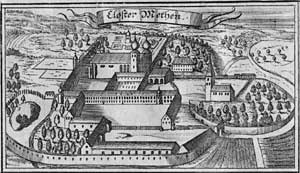
Metten Abbey, or St. Michael's Abbey at Metten is a house of the Benedictine Order in Metten near Deggendorf, situated between the fringes of the Bavarian Forest and the valley of the Danube, in Bavaria in Germany.

Ilmmünster Abbey was a collegiate foundation (Kollegiatstift) of canons, formerly a Benedictine monastery, in Ilmmünster, Bavaria, Germany. The church continues in use as a parish church.

Göttweig Abbey is a Benedictine monastery near Krems in Lower Austria. It was founded in 1083 by Altmann, Bishop of Passau.
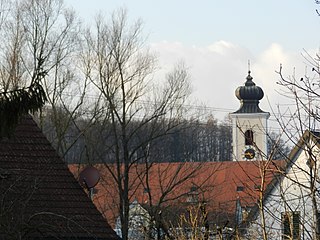
Gleink Abbey was a Benedictine monastery located in the town of Steyr in Austria.

Saint Paul's Abbey in Lavanttal is a Benedictine monastery established in 1091 near the present-day market town of Sankt Paul im Lavanttal in the Austrian state of Carinthia. The premises centered on the Romanesque monastery church were largely rebuilt in a Baroque style in the 17th century.

Berthold of Garsten, O.S.B., also known as Berthold de Rachez, was a German Roman Catholic priest and a monk of the Order of Saint Benedict. He was a noted abbot of a major monastic house in the region, and is revered for the holiness of his life by the Catholic Church.

Saint Blaise Abbey was a Benedictine monastery in the village of St. Blasien in the Black Forest in Baden-Württemberg, Germany.
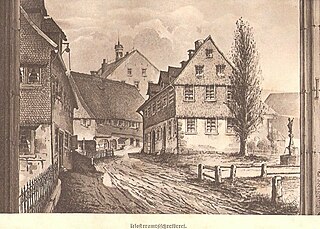
St. George's Abbey in the Black Forest was a Benedictine monastery in St. Georgen im Schwarzwald in the southern Black Forest in Baden-Württemberg, Germany.
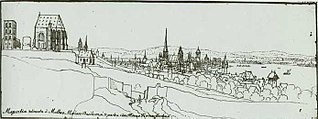
St. Alban's Abbey, Mainz originated as a Benedictine abbey, founded in 787 or 796 by Archbishop Richulf (787–813) in honour of Saint Alban of Mainz, located to the south of Mainz on the hill later called the Albansberg. It was turned into a collegiate foundation (Herrenstift) in 1442. The buildings were entirely destroyed in 1552, although the foundation retained a legal existence until its formal dissolution in 1802.

Rein Abbey is a Cistercian monastery in Rein near Gratwein, Styria, in Austria. Also known as the "Cradle of Styria", it is the oldest surviving Cistercian community in the world.

St. Burchard's Abbey was a Benedictine monastery in Würzburg, Germany, initially known as St. Andrew's Abbey. It was the first abbey established in Würzburg, founded ca. 750. In 1464, it was transformed into a Stift.
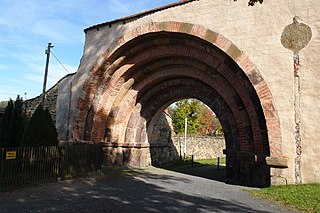
Altzella Abbey, also Altzelle Abbey, is a former Cistercian monastery near Nossen in Saxony, Germany. The former abbey contains the tombs of the Wettin margraves of Meissen from 1190 to 1381.

St. George's Abbey is a monastic complex in the village of Sankt Georgen am Längsee, Carinthia, Austria. It celebrated its 1,000th anniversary in 2003.

Pietro Francesco Carlone, or Peter Franz Carlone, from the Leoben branch of the Carlone family, was an early Baroque architect who was best known for building abbeys.

The St. Nikola Abbey is a former monastery of the Augustinian canons and today's mother house of the German Oratory Sisters in Passau, Lower Bavaria, Germany.

Hornbach Abbey is a former monastery founded around 741 in the historic town of Gamundias by Saint Pirmin, which soon became a Benedictine abbey. The most important neighbouring abbeys were Bausendorf, Saint-Avold, Glandern, Villers-Bettnach, Fraulautern, Mettlach, Tholey, and the stift of St. Arnual. The neighboring spiritual centers were Trier and Metz. At present, all that remains of Hornbach Abbey are the structural remains of the convent buildings, which have been supplemented by a monastery museum, and a modern chapel with the historical tomb of the monastery's founder.